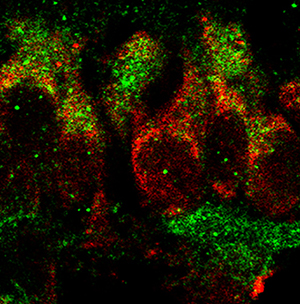Secreted key regulators (Fgf1, Bmp4, Gdf3) are expressed by PAC1-immunopositive retinal ganglion cells in the postnatal rat retina

Submitted: 17 December 2021
Accepted: 2 March 2022
Published: 27 April 2022
Accepted: 2 March 2022
Abstract Views: 839
PDF: 549
HTML: 19
HTML: 19
Publisher's note
All claims expressed in this article are solely those of the authors and do not necessarily represent those of their affiliated organizations, or those of the publisher, the editors and the reviewers. Any product that may be evaluated in this article or claim that may be made by its manufacturer is not guaranteed or endorsed by the publisher.
All claims expressed in this article are solely those of the authors and do not necessarily represent those of their affiliated organizations, or those of the publisher, the editors and the reviewers. Any product that may be evaluated in this article or claim that may be made by its manufacturer is not guaranteed or endorsed by the publisher.
Similar Articles
- CarloAlberto Redi, Cytoskeleton - Methods and Protocols , European Journal of Histochemistry: Vol. 54 No. 1 (2010)
- Maria de Fátima Martins, Paula Martins, Carlos Alberto Gonçalves, Presence of N-acetylgalactosamine/galactose residues on bronchioloalveolar cells during rat postnatal development , European Journal of Histochemistry: Vol. 63 No. 3 (2019)
- Qinan Yin, Introduction to the Special Issue on Stem Cells and Regenerative Medicine , European Journal of Histochemistry: Vol. 64 No. s2 (2020): Special Collection on Stem Cells and Regenerative Medicine
- Danielle Maximo, Diego Demarco, Style head in Apocynaceae: a very complex secretory activity performed by one tissue , European Journal of Histochemistry: Vol. 68 No. 1 (2024): 1954-2024: 70 Years of Histochemical Research
- J. Zhang, J. Luo, J. Ni, L. Tang, H.P. Zhang, L. Zhang, J.F. Xu, D. Zheng, Erratum - MMP-7 is upregulated by COX-2 and promotes proliferation and invasion of lung adenocarcinoma cells , European Journal of Histochemistry: Vol. 68 No. 3 (2024)
- P. Panettiere, D. Accorsi, L. Marchetti, A.M. Minicozzi, G. Orsini, P. Bernardi, D. Benati, G. Conti, A. Sbarbati, The trochanteric fat pad , European Journal of Histochemistry: Vol. 55 No. 2 (2011)
- Carlo Alberto Redi, Cell-penetrating peptides - Methods and protocols , European Journal of Histochemistry: Vol. 55 No. 3 (2011)
- L Ballarin, F Cima, Cytochemical properties of Botryllus schlosseri haemocytes: indications for morpho-functional characterisation , European Journal of Histochemistry: Vol. 49 No. 3 (2005)
- M Boiani, N Crosetto, CA Redi, Pavia symposium on embryos and stem cells , European Journal of Histochemistry: Vol. 52 No. 1 (2008)
- S Matsubara, T Kato, K Oshikawa, T Yamada, T Takayama, T Koike, T Watanabe, A Izumi, I Sato, Glucose-6-phosphate dehydrogenase in rat lung alveolar epithelial cells. An ultrastructural enzyme-cytochemical study , European Journal of Histochemistry: Vol. 46 No. 3 (2002)
<< < 56 57 58 59 60 61 62 63 64 65 > >>
You may also start an advanced similarity search for this article.

 https://doi.org/10.4081/ejh.2022.3373
https://doi.org/10.4081/ejh.2022.3373











